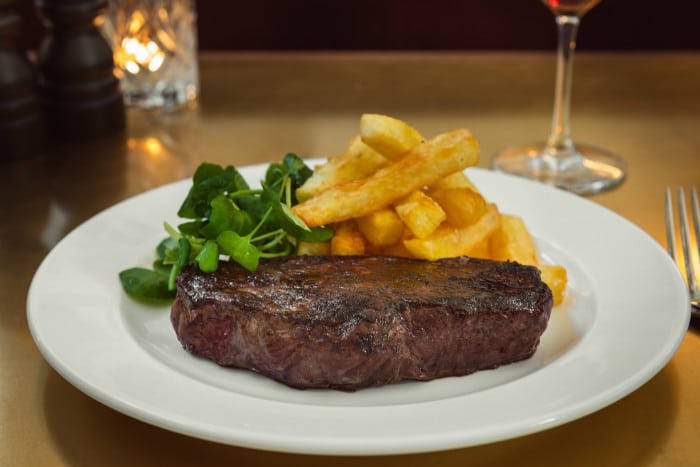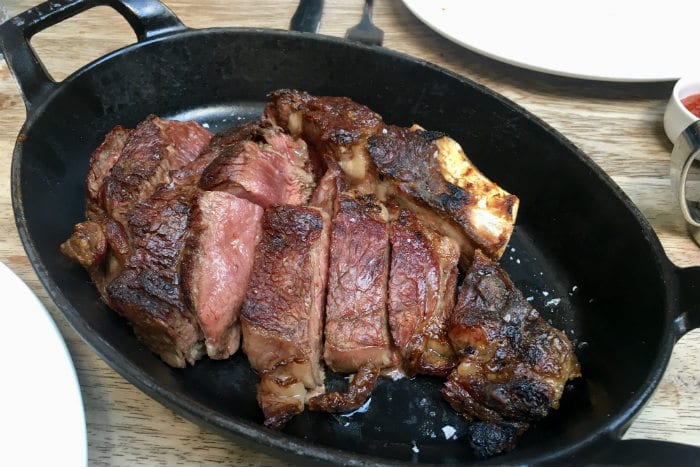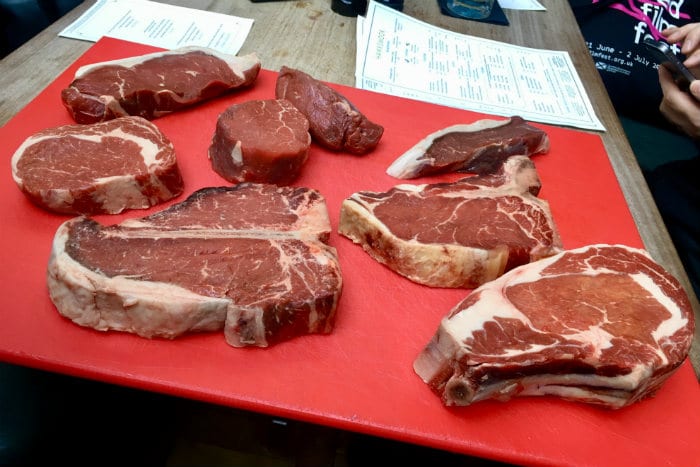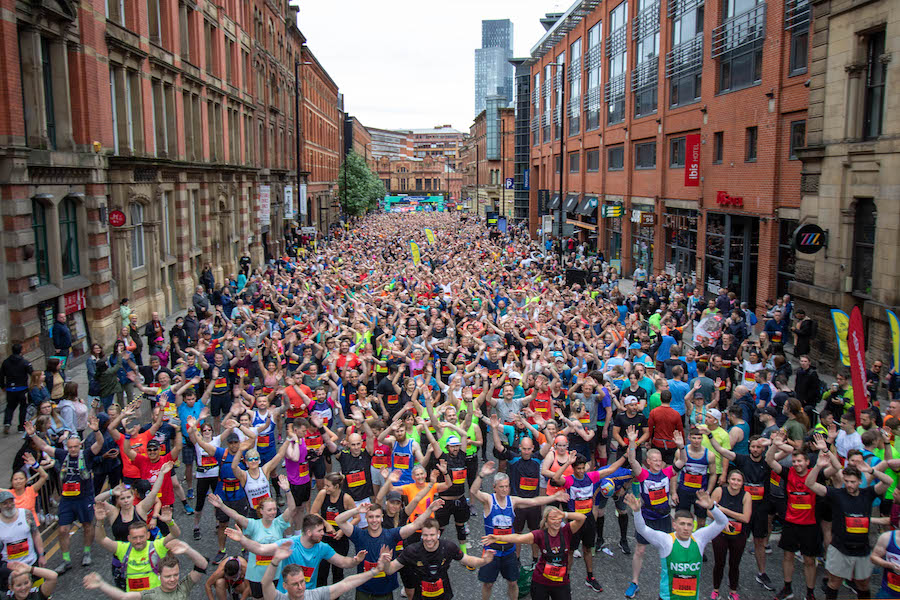How to cook the perfect steak and chips at home – with help from Hawksmoor
- Written by Louise Rhind-Tutt
- Last updated 5 years ago
- Food & Drink, Lifestyle

We’re all missing restaurants. If you’re anything like us, you probably find yourself fantasizing about the place you want to go first when it’s safe to do so – and what you’ll order.
For me, it’s Hawksmoor. I dream about their big cuts of beef, the primeval pleasure of fire and flesh from charred crust to satisfying chew, the robust savoury flavours giving way to sweet, bloody juiciness. While I can cook a fairly decent steak and chips at home, it’s not a patch on Hawksmoor’s.
Here, the experts on all things beefy share their tips with us on how to improve your steak game at home, from what kind of meat to buy to how to cook, season and rest it.
Plus, they’ve shared the recipe for their signature triple cooked chips, so you can give them a go on your next steak night. They’re pretty much the perfect chips, all crisp and golden and unashamedly delicious. Now all you need is a good bottle of red.
How to cook steak at home – tips from Hawksmoor

If you don’t happen to have a charcoal grill, a Josper or a Thermodyne at home, fear not, you can still cook a great steak. Here’s how.
- Buy good meat. This is the key. But it can be easier said than done – our advice is to find a good butcher and ask lots of questions.
- Buy big. The aim is to get a good char on the outside while keeping the meat juicy and tender inside; this is very difficult with a thin piece of meat. Ideally each steak should be at least 300g, and 4cm thick. Or buy bigger and share a steak between a couple of people.
- Take the meat out of the fridge at least an hour before you cook it, to bring it up to room temperature.
- Fire up the barbecue. Or, if it’s raining, dig out a heavy cast-iron griddle pan. If you’re using a barbecue we recommend lumpwood charcoal from sustainable sources, and make sure you use eco-friendly non-impregnated firelighters, to avoid any fuel tainting the flavour of the meat. There are three ingredients in a steak: beef, charcoal and salt. Getting all three right is crucial – there’s no point buying a beautiful piece of beef and using lighter-fuel-impregnated briquettes from the local petrol station.
- Get the pan or the barbecue really, really hot. You’re looking for white-hot coals on the barbecue, which will take about an hour from lighting. The grill pan needs 5 minutes over a high heat. It should be painful to hold your hand anywhere near the heat source, which is why our grill chefs have to drink so much water.
- If you’re inside, open the window – there will be lots of smoke.
- If your steak is wet, pat it dry with kitchen paper, otherwise it will struggle to form a decent crust and can pick up some unpleasant boiled-meat flavours. And then, at the last minute, season the meat well with Maldon sea salt. You will need to use more than you probably think sensible, but it will help build a delicious salty crust. Pick up a handful of salt in your right hand and your steak in your left. Assuming your steak is the right size (at least 300g and 4cm thick), throw the salt at it and whatever sticks is the right amount. Move the steak around so every surface is coated. If you’re cooking a large sharing steak you’ll need to pat the salt in a little to give you more (yes, more). And if you’ve ended up with skinny minute steaks, use a fair bit less.
- Don’t use any oil on the meat or in the pan – if the grill is hot enough the meat won’t stick. As well as being unnecessary, oil tends to add a hint of flavour that doesn’t sit well with good beef. If you’re really worried, you can cut a small piece of fat off your steak (or ask your butcher for a piece) and rub it over the grill with a pair of tongs.
- Stick the steak on. Leave it for a couple of moments to start building up a crust, then flip. Carry on turning every couple of minutes until it’s the way you like it, and don’t forget to sear the edges. If the head is as fierce as our charcoal grill at Hawksmoor you may need to move it more regularly to avoid burning – our grill chefs say every 5 seconds. Don’t overcrowd the grill or pan – make sure there’s plenty of space between the steaks.
- To check if your steak is cooked, you can use touch, which our grill chefs do, or you can use a probe, which our grill chefs also do to make sure every steak is perfect. Cooking temperatures are subjective and perceptions even vary from country to country. These are a touch more cooked than they might be in France or Spain. The internal temperature should be at the bottom end of each range at the end of cooking and towards the top end once rested. Medium rare 55°c to 60°c; medium 60°c to 65°c; medium well 65°c to 70°c.
- When you’re happy with how it is cooked, put the steak on a warm plate and leave it to rest. In the restaurant we rest meat at 56°c (in a Thermodyne – a special low-temperature oven) to ensure it doesn’t get cold, which means we can rest it for longer. At home, 5 minutes for a single steak or 10-15 minutes for a large sharing steak on a warm plate should do it. Serve on hot plates.
Questions for your butcher – and the ideal answers

Q: What breed of cattle does the beef come from?
A: A traditional British breed.
Q: What did it spend its life eating?
A: Grass.
Q: At what age was it slaughtered?
A: 24-30 months.
Q: How was the meat aged and for how long?
A: Dry-aged for at least 28 days.
How to make Hawksmoor’s triple-cooked chips
Crisp and golden, these are the perfect accompaniment for any steak. You’ll need to prepare them a couple of days in advance, as they need to rest overnight between the stages – then you just do the final fry once your steak is ready.
Serves 4.
Ingredients:
- 1.5kg Maris Piper potatoes
- 4 litres vegetable oil
- Sea salt
- Malt vinegar
Method:
- Cut the potatoes into chips – approximately 2cm x 2cm x 6cm.
- Once cut, wash the chips under cold running water to remove some of the starch.
- Drain the chips, then put them into a pan of cold salted water. Place the pan on the heat and simmer until almost cooked through, about 10 minutes.
- Carefully drain the chips, then put them into a roasting tray and allow them to air-dry for a few minutes. Give the tray a shake to chuff up the chips – this opens up tiny fissures on the surface, which make for crispy golden chips. Allow them to air-dry and cool overnight in the fridge to remove moisture.
- Heat the vegetable oil to 140°c and blanch the chips for 5 minutes, until cooked through but only very lightly coloured.
- Remove from the fryer, air-dry until cool and again, leave in the fridge overnight.
- Once your steak is ready and resting, increase the heat of the oil to 190°c and fry the chips until golden brown. Season with salt and a spray of vinegar and serve.
Find more recipes and top tips in Hawksmoor’s two excellent cook books, Hawksmoor at Home and Hawksmoor: Restaurants & Recipes.
- This article was last updated 5 years ago.
- It was first published on 26 May 2020 and is subject to be updated from time to time. Please refresh or return to see the latest version.
Did we miss something? Let us know: press@ilovemanchester.com
Want to be the first to receive all the latest news stories, what’s on and events from the heart of Manchester? Sign up here.
Manchester is a successful city, but many people suffer. I Love Manchester helps raise awareness and funds to help improve the lives and prospects of people across Greater Manchester – and we can’t do it without your help. So please support us with what you can so we can continue to spread the love. Thank you in advance!
An email you’ll love. Subscribe to our newsletter to get the latest news stories delivered direct to your inbox.
Got a story worth sharing?
What’s the story? We are all ears when it comes to positive news and inspiring stories. You can send story ideas to press@ilovemanchester.com
While we can’t guarantee to publish everything, we will always consider any enquiry or idea that promotes:
- Independent new openings
- Human interest
- Not-for-profit organisations
- Community Interest Companies (CiCs) and projects
- Charities and charitable initiatives
- Affordability and offers saving people over 20%
For anything else, don’t hesitate to get in touch with us about advertorials (from £350+VAT) and advertising opportunities: advertise@ilovemanchester.com

Now you can own a piece of TV history and support a much loved NHS Charity

The welcoming Manchester community where board games build friendships

Everything you need to know about the St George’s Day Parade 2025

Best bars and pubs to watch the football and live sport in Manchester

Discotheque Royale vs Piccadilly 21s: which was your favourite 90s Manchester club?
















